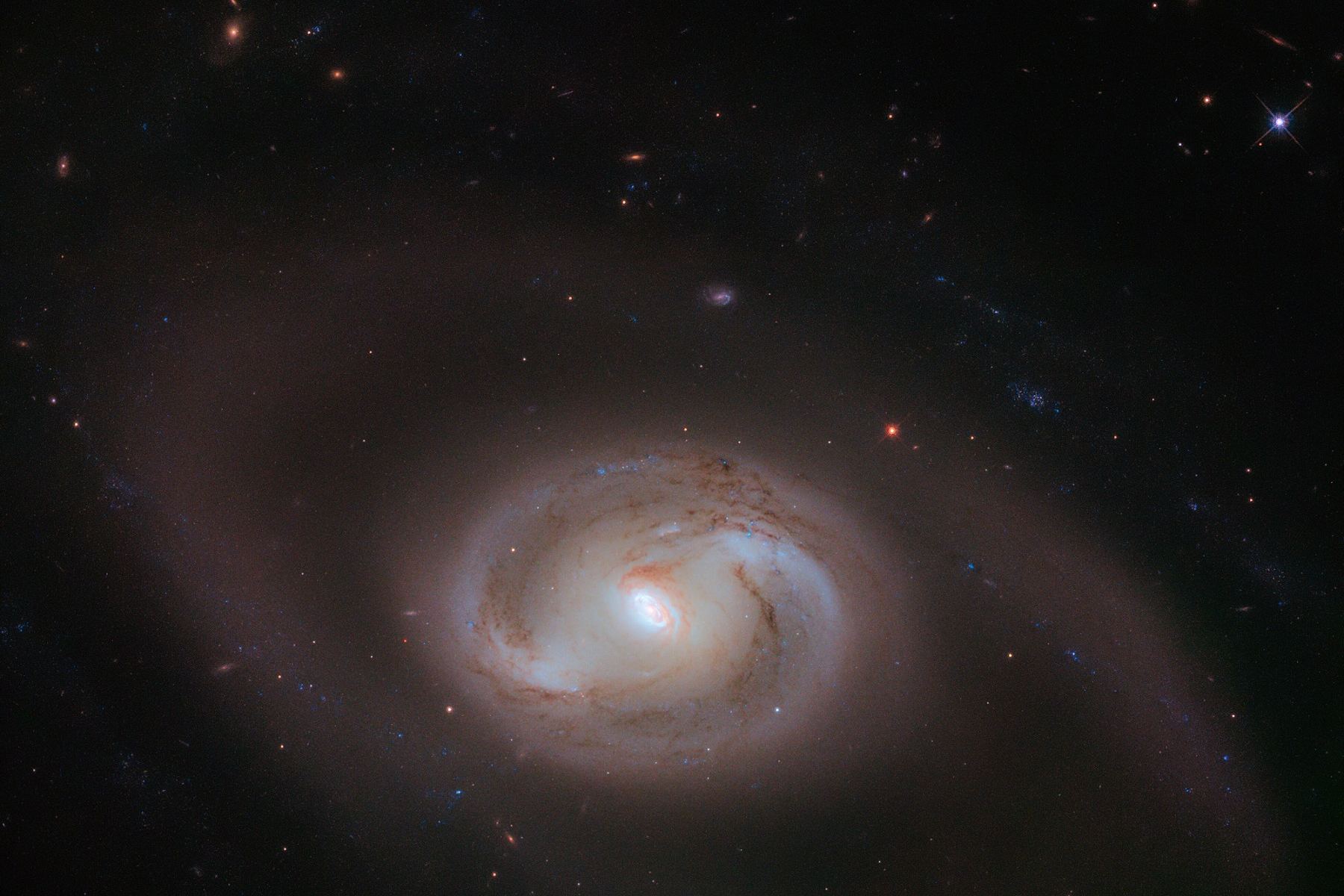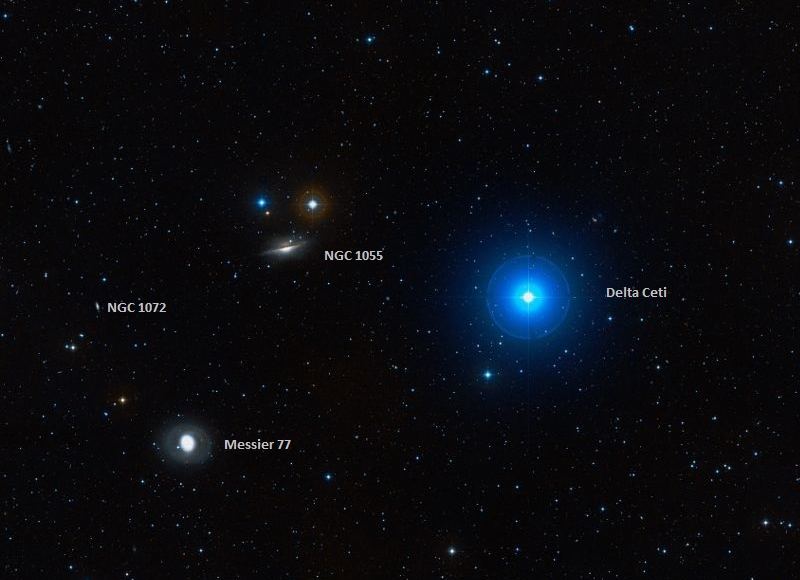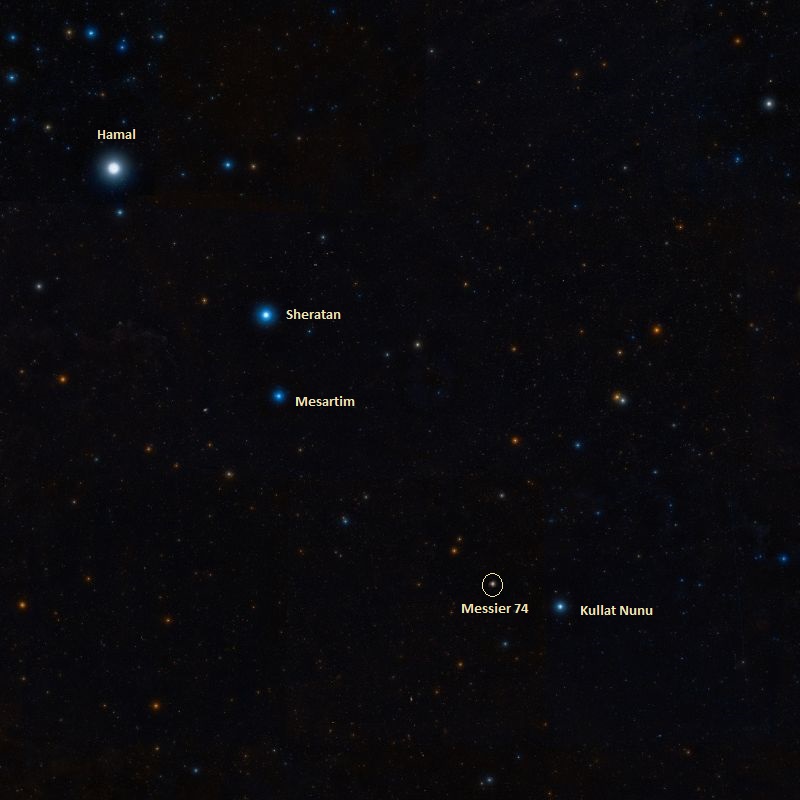Even after thirty years of faithful service, the Hubble Space Telescope continues to reveal truly fascinating things about our Universe. This includes the image (shown at top) taken of the astronomical feature known as NGC 2273, a barred spiral galaxy similar to the Milky Way. However, upon closer inspection, the image reveals that the spiral arms of this galaxy contain a second set of spiral arms.
Continue reading “Hubble Sees a Galaxy With Spiral Arms, Surrounded by Other Spiral Arms”Messier 88 – the NGC 4501 Spiral Galaxy
Welcome back to Messier Monday! Today, we continue in our tribute to our dear friend, Tammy Plotner, by looking at the spiral galaxy known as Messier 88!
During the 18th century, famed French astronomer Charles Messier noticed the presence of several “nebulous objects” while surveying the night sky. Originally mistaking these objects for comets, he began to catalog them so that others would not make the same mistake. Today, the resulting list (known as the Messier Catalog) includes over 100 objects and is one of the most influential catalogs of Deep Space Objects.
One of these objects is the spiral galaxy known as Messier 88 (New General Catalog designation 4501), a spiral galaxy located between 50 and 60 million light-years away in the constellation Coma Berenices. M88 was one of the first celestial objects to be recognized as a spiral galaxy and is one of the brighter galaxies of its kind in the Virgo Cluster.
Messier 77 – the Cetus A Barred Spiral Galaxy
Welcome back to Messier Monday! Today, we continue in our tribute to our dear friend, Tammy Plotner, by looking at Cetus A, the barred spiral galaxy known as Messier 77!
During the 18th century, famed French astronomer Charles Messier noticed the presence of several “nebulous objects” while surveying the night sky. Originally mistaking these objects for comets, he began to catalog them so that others would not make the same mistake. Today, the resulting list (known as the Messier Catalog) includes over 100 objects and is one of the most influential catalogs of Deep Space Objects.
One of these objects is known as Messier 77 (aka. Cetus A), a barred spiral galaxy located 47 million light-years from Earth in the constellation Cetus. Measuring some 170,000 light-years in diameter, it is one of the largest galaxies included in the Messier Catalog. Its size and bright core also make it relatively easy to spot with binoculars or small telescopes.
Continue reading “Messier 77 – the Cetus A Barred Spiral Galaxy”
Messier 74 – the NGC 628 Spiral Galaxy
Welcome back to Messier Monday! Today, we continue in our tribute to our dear friend, Tammy Plotner, by looking at the “Phantom Galaxy” known as Messier 74!
During the 18th century, famed French astronomer Charles Messier noticed the presence of several “nebulous objects” while surveying the night sky. Originally mistaking these objects for comets, he began to catalog them so that others would not make the same mistake. Today, the resulting list (known as the Messier Catalog) includes over 100 objects and is one of the most influential catalogs of Deep Space Objects.
One of these objects is the spiral galaxy known as Messier 74 (aka. the Phantom Galaxy) which appears face-on to observers from Earth. Located about 30 million light years from Earth in the direction of the Pisces constellation, this galaxy measures around 95,000 light years in diameter (almost as big as the Milky Way) and is home to about 100 billion stars. Continue reading “Messier 74 – the NGC 628 Spiral Galaxy”
Messier 63 – the Sunflower Galaxy
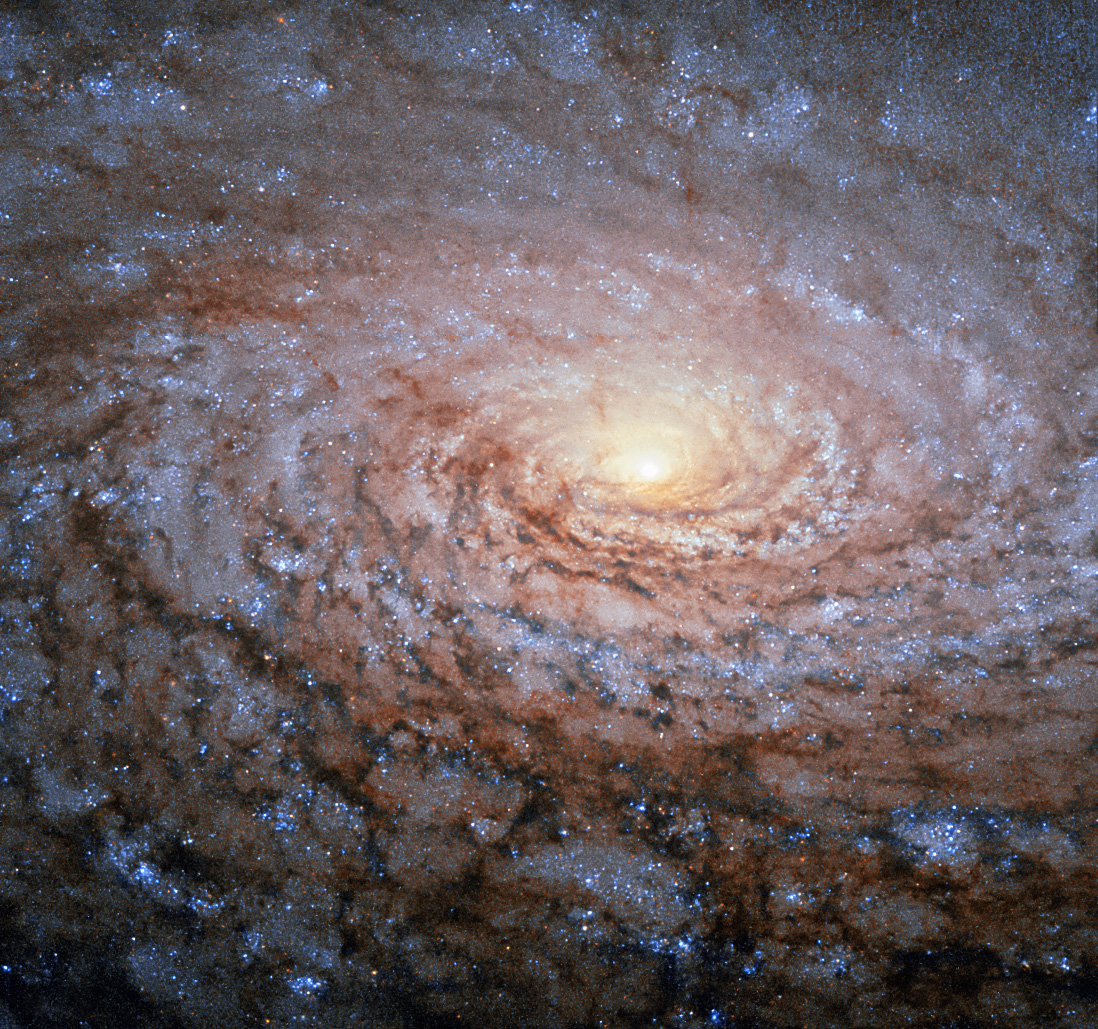
Welcome back to Messier Monday! Today, we continue in our tribute to our dear friend, Tammy Plotner, by looking at the “Sunflower Galaxy”, otherwise known as Messier 63.
In the 18th century, while searching the night sky for comets, French astronomer Charles Messier kept noting the presence of fixed, diffuse objects he initially mistook for comets. In time, he would come to compile a list of approximately 100 of these objects, hoping to prevent other astronomers from making the same mistake. This list – known as the Messier Catalog – would go on to become one of the most influential catalogs of Deep Sky Objects.
One of these objects is the spiral galaxy known as Messier 63 – aka. the Sunflower Galaxy. Located in the Canes Venatici constellation, this galaxy is located roughly 37 million light-years from Earth and has an active nucleus. Messier 63 is part of the M51 Group, a group of galaxies that also includes Messier 51 (the ‘Whirlpool Galaxy’), and can be easily spotted using binoculars and small telescopes.
Description:
Messier 63 is what is known as a a flocculent spiral galaxy, consisting of a central disc surrounded by many short spiral arm segments – one not connected by a central bar structure. Drifting along in space some 37,000 light years from our own galaxy, we known it interacts gravitationally with M51 (the Whirlpool Galaxy) and we also know that its outer regions are rotating so quickly that if it weren’t for dark matter – it would rip itself apart.
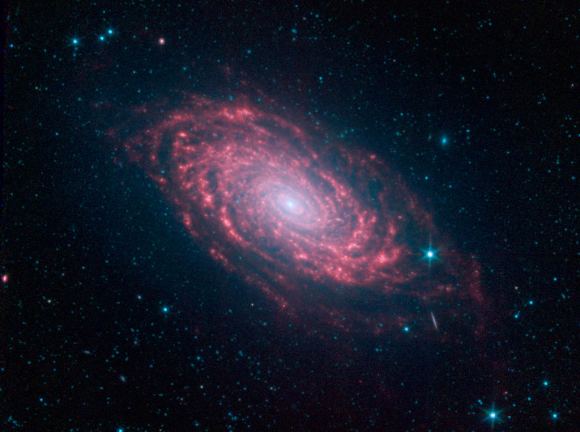
As Michele D. Thornley and Lee G. Mundy, of the Maryland University Department of Astronomy, indicated in a 1997 study:
“The morphology and inematics described by VLA observations of H I emission and FCRAO and Berkeley-Illinois-Maryland Association (BIMA) Array observations of CO emission provide evidence for the presence of low-amplitude density waves in NGC 5055. The distribution of CO and H I emission suggests enhanced gas surface densities along the NIR spiral arms, and structures similar to the giant molecular associations found in the grand design spirals M51 and M100 are detected. An analysis of H I and H? velocity fields shows the kinematic signature of streaming motions similar in magnitude to those of M100 in both tracers. The lesser degree of organization along the spiral arms of NGC 5055 may be due to the lower overall gas surface density, which in the arms of NGC 5055 is a factor of 2 lower than in M100 and a factor of 6 lower than in M51; an analysis of gravitational instability shows the gas in the arms is only marginally unstable and the interarm gas is marginally stable. The limited extent of the spiral arm pattern is consistent with an isolated density wave with a relatively high pattern speed.”
There very well could be a massive object hidden within. As Sebastien Blais-Ouellette of the Universite de Montreal said in a 1998 study:
“In a global kinematical study of NGC 5055 using high resolution Fabry-Perot, intriguing spectral line profiles have been observed in the center of the galaxy. These profiles seem to indicate a rapidly rotating disk with a radius near 365 pc and tilted 50 deg with respect to the major axis of the galaxy. In the hypothesis of a massive dark object, a naive keplerian estimate gives a mass around 10^7.2 to 10^7.5 M.”
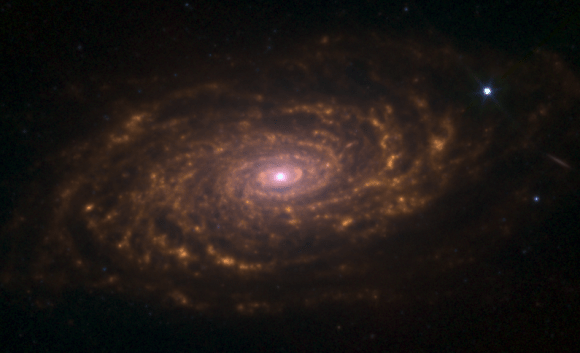
But that’s not all they’ve found either… How about a lopsided, chemically unbalanced nucleus! As V.L. Afanasiev (et al) pointed out in their 2002 study:
“We have found a resolved chemically distinct core in NGC 5055, with the magnesium-enhanced region shifted by 2″.5 (100 pc) to the south-west from a photometric center, toward a kinematically identified circumnuclear stellar disk. Mean ages of stellar populations in the true nucleus, defined as the photometric center, and in the magnesium-enhanced substructure are coincident and equal to 3-4 Gyr being younger by several Gyr with respect to the bulge stellar population.”
Yep. It might be beautiful, but it’s warped. As G. Battaglia of the Kapteyn Astronomical Institute indicated in a 2005 study:
“NGC 5055 shows remarkable overall regularity and symmetry. A mild lopsidedness is noticeable, however, both in the distribution and kinematics of the gas. The tilted ring analysis of the velocity field led us to adopt different values for the kinematical centre and for the systemic velocity for the inner and the outer parts of the system. This has produced a remarkable result: the kinematical and geometrical asymmetries disappear, both at the same time. These results point at two different dynamical regimes: an inner region dominated by the stellar disk and an outer one, dominated by a dark matter halo offset with respect to the disk.”
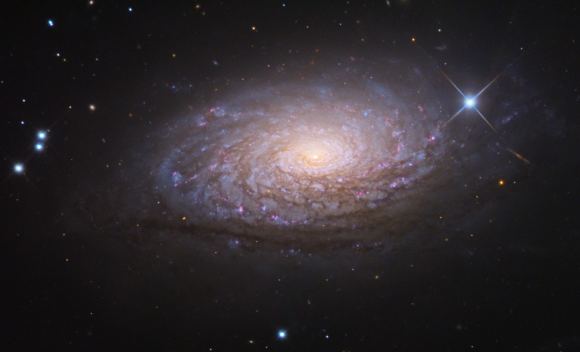
History of Observation:
Messier Object 63 was the very first discovery by Charles Messier’s friend and assistant Pierre Mechain, who turned it up on June 14, 1779. While Mechain himself did not write the notes, Messier did:
“Nebula discovered by M. Mechain in Canes Venatici. M. Messier searched for it; it is faint, it has nearly the same light as the nebula reported under no. 59: it contains no star, and the slightest illumination of the micrometer wires makes it disappear: it is close to a star of 8th magnitude, which precedes the nebula on the hour wire. M. Messier has reported its position on the Chart of the path of the Comet of 1779.”
Messier 63 would go on to be observed and resolved by Sir William Herschel and cataloged by his son John. It would be descriptively narrated by Admiral Symth and exclaimed over by many astronomers – one of the best of which was Lord Rosse: “Spiral? Darkness south flowing nucleus.” Of all the descriptions, perhaps the best belongs to Curtis, who first photographed it with the Crossley Reflector at Lick Observatory: “Has an almost stellar nucleus. The whorls are narrow, very compactly arranged, and show numerous almost stellar condensations.”
Locating Messier 63:
The beautiful Sunflower Galaxy is among one of the easiest of the Messier objects to find. It’s located almost precisely between Cor Caroli (Alpha Canes Venetici) and Eta Ursa Majoris. With the slightest of optical aid, stars 19, 20 and 23 CnV will show easily in finderscope or binoculars and M63 will be positioned right around two degrees away towards Eta UM.
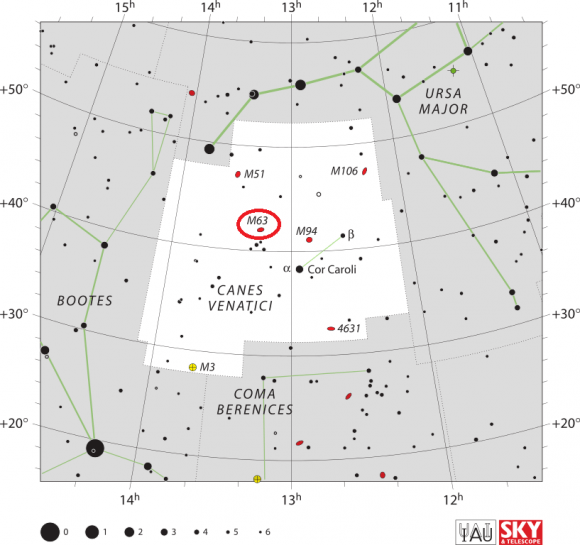
While this spiral galaxy has a nice overall brightness, it’s going to be very faint for binoculars, only showing as the tiniest contrast change in smaller models. However, even a modest telescope will easily see a faint oval shape with a concentrated nucleus. The more aperture you apply, the more details you will see. As size approaches 8″ and larger, expect to see spiral structure!
Power up… And look for the spiral in the Sunflower!
Object Name: Messier 63
Alternative Designations: M63, NGC 5055, Sunflower Galaxy
Object Type: Type Sb Spiral Galaxy
Constellation: Canes Venatici
Right Ascension: 13 : 15.8 (h:m)
Declination: +42 : 02 (deg:m)
Distance: 37000 (kly)
Visual Brightness: 8.6 (mag)
Apparent Dimension: 10×6 (arc min)
We have written many interesting articles about Messier Objects here at Universe Today. Here’s Tammy Plotner’s Introduction to the Messier Objects, M1 – The Crab Nebula, and David Dickison’s articles on the 2013 and 2014 Messier Marathons.
Be to sure to check out our complete Messier Catalog. And for more information, check out the SEDS Messier Database.
Sources:
Cutting-Edge Astronomy Confirms Most Ancient Galaxy to Date
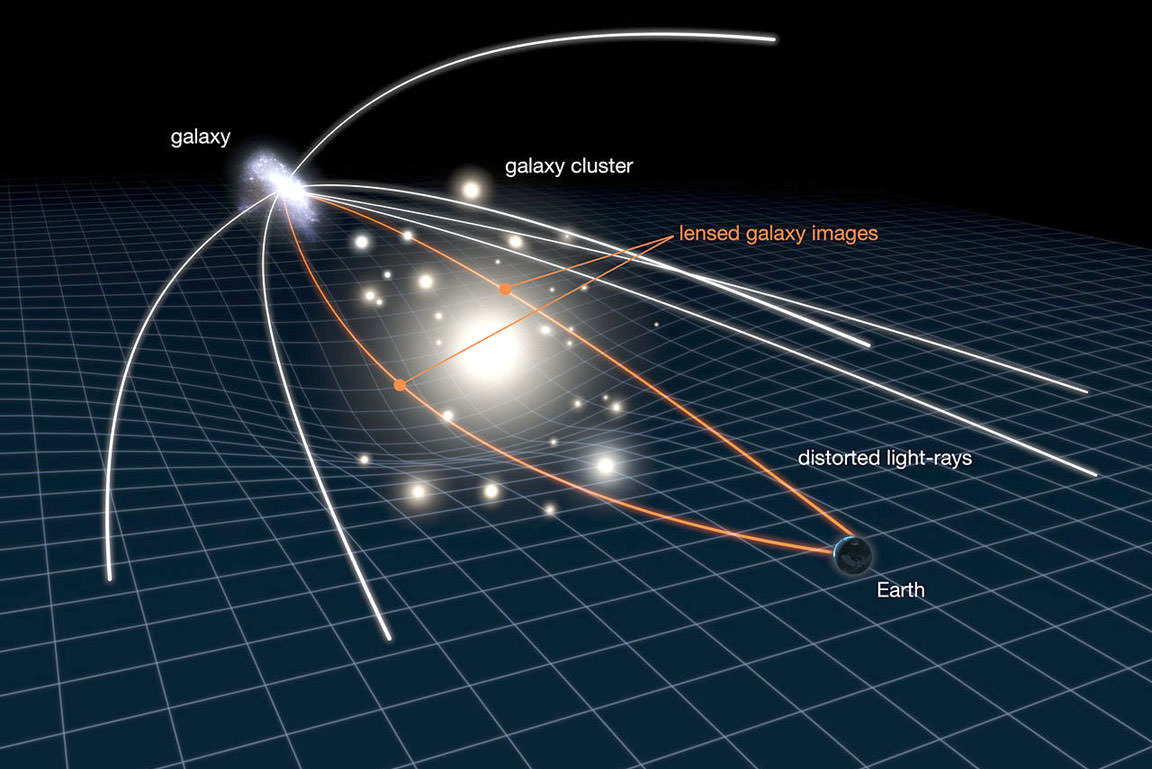
Since the deployment of the Hubble Space Telescope, astronomers have been able to look deeper into the cosmic web than ever before. The farther they’ve looked, the deeper back in time they are able to see, and thus learn what the Universe looked like billions of years ago. With the deployment of other cutting-edge telescopes and observatories, scientists have been able to learn a great deal more about the history and evolution of the cosmos.
Most recently, an international team of astronomers using the Gemini North Telescope in Hawaii were able to spot a spiral galaxy located 11 billion light years away. Thanks to a new technique that combined gravitational lensing and spectrography, they were able to see an object that existed just 2.6 billion years after the Big Bang. This makes this spiral galaxy, known as A1689B11, the oldest and most distant spiral galaxy spotted to date.
The study which details the team’s findings, titled “The most ancient spiral galaxy: a 2.6-Gyr-old disk with a tranquil velocity field“, recently appeared in The Astrophysical Journal. The team consisted of members from the Swinburne University of Technology, the Australian Research Council Center of Excellence in All Sky Astrophysics in 3D (ASTRO 3D), the University of Lyon, Princeton University, and the Racah Institute of Physics at The Hebrew University in Jerusalem.
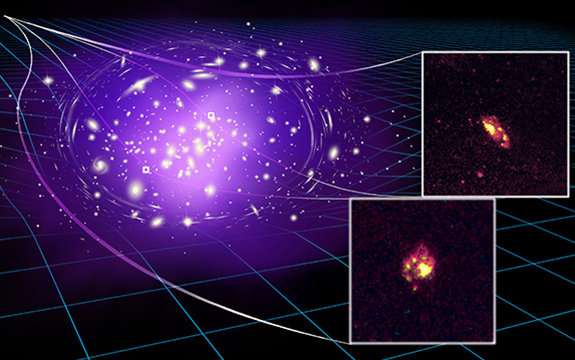
Together, the team relied on the gravitational lensing technique to spot A1689B11. This technique has become a mainstay for astronomers, and involves using a large object (like a galaxy cluster) to bend and magnify the light of a galaxy located behind it. As Dr. Tiantian Yuan, a Swinburne astronomer and the lead author on the research study, explained in a Swinburne press statement:
“This technique allows us to study ancient galaxies in high resolution with unprecedented detail. We are able to look 11 billion years back in time and directly witness the formation of the first, primitive spiral arms of a galaxy.”
They then used the Near-infrared Integral Field Spectrograph (NIFS) on the Gemini North telescope to verify the structure and nature of this spiral galaxy. This instrument was built Peter McGregor of The Australian National University (ANU), which now is responsible for maintaining it. Thanks to this latest discovery, astronomers now have some additional clues as to how galaxies took on the forms that we are familiar with today.
Based on the classification scheme developed by famed astronomer Edwin Hubble (the “Hubble Sequence“), galaxies are divides into 3 broad classes based on their shapes – ellipticals, lenticulars and spirals – with a fourth category reserved for “irregularly-shaped” galaxies. In accordance with this scheme, galaxies start out as elliptical structures before branching off to become spiraled, lenticular, or irregular.
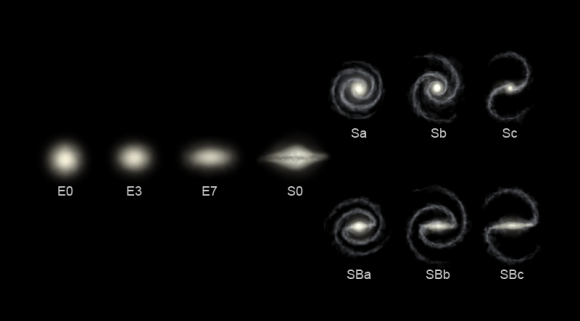
As such, the discovery of such an ancient spiral galaxy is crucial to determining when and how the earliest galaxies began changing from being elliptical to taking on their modern forms. As Dr Renyue Cen, an astronomer from Princeton University and a co-author on the study, says:
“Studying ancient spirals like A1689B11 is a key to unlocking the mystery of how and when the Hubble sequence emerges. Spiral galaxies are exceptionally rare in the early Universe, and this discovery opens the door to investigating how galaxies transition from highly chaotic, turbulent discs to tranquil, thin discs like those of our own Milky Way galaxy.”
On top of that, this study showed that the A1689B11 spiral galaxy has some surprising features which could also help inform (and challenge) our understanding of this period in cosmic history. As Dr. Yuan explained, these features are in stark contrast to galaxies as they exist today. But equally interesting is the fact that it also differentiates this spiral galaxy from other galaxies that are similar in age.
“This galaxy is forming stars 20 times faster than galaxies today – as fast as other young galaxies of similar masses in the early Universe,” said Dr. Yuan. “However, unlike other galaxies of the same epoch, A1689B11 has a very cool and thin disc, rotating calmly with surprisingly little turbulence. This type of spiral galaxy has never been seen before at this early epoch of the Universe!”
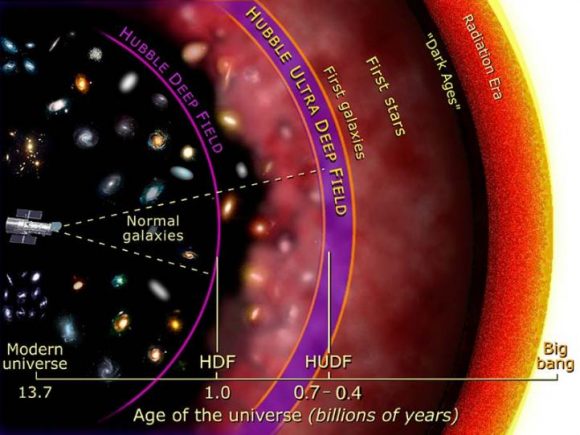
In the future, the team hopes to conduct further studies of this galaxy to further resolve its structure and nature, and to compare it to other spiral galaxies from this epoch. Of particular interest to them is when the onset of spiral arms takes place, which should serve as a sort of boundary marker between ancient elliptical galaxies and modern spiral, lenticular and irregular shapes.
They will continue to rely on the NIFS to conduct these studies, but the team also hopes to rely on data collected by the James Webb Space Telescope (which will be launched in 2019). These and other surveys in the coming years are expected to reveal vital information about the earliest galaxies in the Universe, and reveal further clues as to how it changed over time.
What Is the Name Of Our Galaxy?

Since prehistoric times, human beings have looked up at at the night sky and pondered the mystery of the band of light that stretches across the heavens. And while theories have been advanced since the days of Ancient Greece as to what it could be, it was only with the birth of modern astronomy that scholars have come come to know precisely what it is – i.e. countless stars at considerable distances from Earth.
The term “Milky Way”, a term which emerged in Classical Antiquity to describe the band of light in the night sky, has since gone on to become the name for our galaxy. Like many others in the known Universe, the Milky Way is a barred, spiral galaxy that is part of the Local Group – a collection of 54 galaxies. Measuring 100,000 – 180,000 light-years in diameter, the Milky Way consists of between 100 and 400 billion stars.
Structure:
The Milky Way consists of a Galactic Center that is shaped like a bar and a Galactic Disk made up of spiral arms, all of which is surrounded by the Halo – which is made up of old stars and globular clusters. The Center, also known as “the bulge”, is a dense concentration of mostly old stars that measures about 10,000 light years in radius. This region is also the rotational center of the Milky Way.
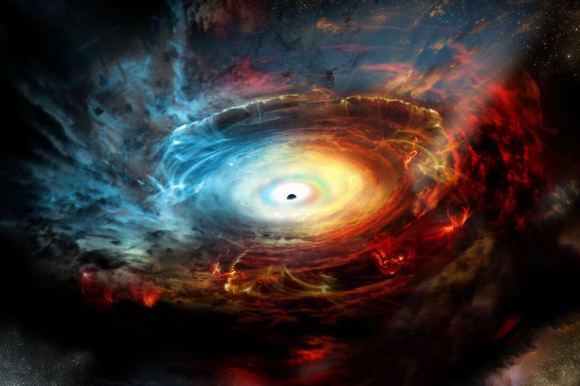
The Galactic Center is also home to an intense radio source named Sagittarius A*, which is believed to have a supermassive black hole (SMBH) at its center. The presence of this black hole has been discerned due to the apparent gravitational influence it has on surrounding stars. Astronomers estimate that it has a mass of between 4.1. and 4.5 million Solar masses.
Outside the barred bulge at the Galactic Center is the Galactic Disk of the Milky Way. This consists of stars, gas and dust which is organized into four spiral arms. These arms typically contain a higher density of interstellar gas and dust than the Galactic average, as well as a greater concentration of star formation. While there is no consensus on the exact structure or extent of these spiral arms, they are commonly grouped into two or four different arms.
In the case of four arms, this is based on the traced paths of gas and younger stars in our galaxy, which corresponds to the Perseus Arm, the Norma and Outer Arm, the Scutum-Centaurum Arm, and the Carina-Sagittarius Arm. There are also at least two smaller arms, which include the Cygnus Arm and the Orion Arm. Meanwhile, surveys based on the presence of older stars show only two major spirals arms – the Perseus arm and the Scutum–Centaurus arm.
Beyond the Galactic Disk is the Halo, which is made up of old stars and globular clusters – 90% of which lie within 100,000 light-years (30,000 parsecs) from the Galactic Center. Recent evidence provided by X-ray observatories indicates that in addition to this stellar halo, the Milky way also has a halo of hot gas that extends for hundreds of thousands of light years.
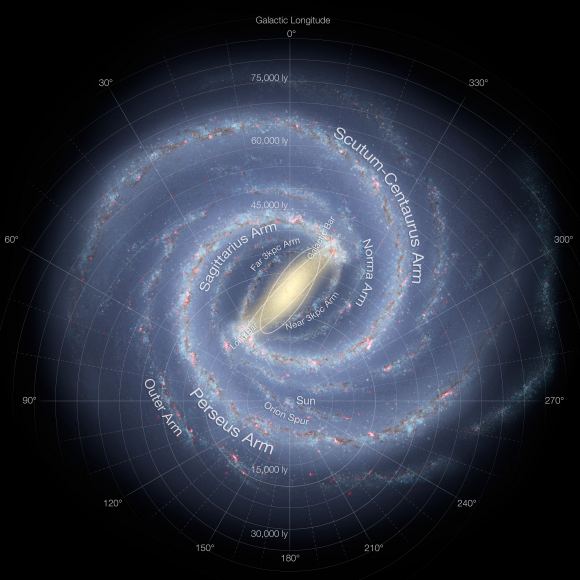
Size and Mass:
The Galactic Disk of the Milky Way Galaxy is approximately 100,000 light years in diameter and about 1,000 light years thick. It is estimated to contain between 100 and 400 billion stars, though the exact figure depends on the number of very low-mass M-type (aka. red dwarf) stars. This is difficult to determine because these stars also have low-luminosity compared to other class.
The distance from the Sun to the Galactic Center is estimated to be between 25,000 to 28,000 light years (7,600 to 8,700 parsecs). The Galactic Center’s bar (aka. its “bulge”) is thought to be about 27,000 light-years in length and is composed primarily of red stars, all of which are thought to be ancient. The bar is surrounded by the ‘5-kpc ring’, a region that contains much of the galaxy’s molecular hydrogen and where star-formation is most intense.
The Galactic Disk has a diameter of between 70,000 and 100,000 light-years. It does not have a sharp edge, a radius beyond which there are no stars. However, the number of stars drops slowly with distance from the center. Beyond a radius of roughly 40,000 light years, the number of stars drops much faster the farther you get from the center.
Location of the Solar System:
The Solar System is located near the inner rim of the Orion Arm, a minor spiral arm located between the Carina–Sagittarius Arm and the Perseus Arm. This arm measures some 3,500 light-years (1,100 parsecs) across, approximately 10,000 light-years (3,100 parsecs) in length, and is at a distance of about 25,400 to 27,400 light years (7.78 to 8.4 thousand parsecs) from the Galactic Center.
History of Observation:
Our galaxy was named because of the way the haze it casts in the night sky resembled spilled milk. This name is also quite ancient. It is translation from the Latin “Via Lactea“, which in turn was translated from the Greek for Galaxias, referring to the pale band of light formed by stars in the galactic plane as seen from Earth.
Persian astronomer Nasir al-Din al-Tusi (1201–1274) even spelled it out in his book Tadhkira: “The Milky Way, i.e. the Galaxy, is made up of a very large number of small, tightly clustered stars, which, on account of their concentration and smallness, seem to be cloudy patches. Because of this, it was likened to milk in color.”
Astronomers had long suspected the Milky Way was made up of stars, but it wasn’t proven until 1610, when Galileo Galilei turned his rudimentary telescope towards the heavens and resolved individual stars in the band across the sky. With the help of telescopes, astronomers realized that there were many, many more stars in the sky, and that all of the ones that we can see are a part of the Milky Way.
In 1755, Immanuel Kant proposed that the Milky Way was a large collection of stars held together by mutual gravity. Just like the Solar System, this collection would be rotating and flattened out as a disk, with the Solar System embedded within it. Astronomer William Herschel (discoverer of Uranus) tried to map its shape in 1785, but he didn’t realize that large portions of the galaxy are obscured by gas and dust, which hide its true shape.
It wasn’t until the 1920s, when Edwin Hubble provided conclusive evidence that the spiral nebulae in the sky were actually whole other galaxies, that the true shape of our galaxy was known. Thenceforth, astronomers came to understand that the Milky Way is a barred, spiral galaxy, and also came to appreciate how big the Universe truly is.
The Milky Way is appropriately named, being the vast and cloudy mass of stars, dust and gas it is. Like all galaxies, ours is believed to have formed from many smaller galaxies colliding and combining in the past. And in 3 to 4 billion years, it will collide with the Andromeda Galaxy to form an even larger mass of stars, gas and dust. Assuming humanity still exists by then (and survives the process) it should make for some interesting viewing!
We have written many interesting articles about the Milky Way here at Universe Today. Here’s 10 Interesting Facts About the Milky Way, How Big is the Milky Way?, Why is our Galaxy Called the Milky Way?, What is the Closest Galaxy to the Milky Way?, Where is the Earth in the Milky Way?, The Milky Way has Only Two Spiral Arms, and It’s Inevitable: Milky Way, Andromeda Galaxy Heading for Collision.
If you’d like more info on galaxies, check out Hubblesite’s News Releases on Galaxies, and here’s NASA’s Science Page on Galaxies.
We’ve also recorded an episode of Astronomy Cast about the Milky Way. Listen here, Episode 99: The Milky Way.
Sources:
The Crater Constellation
Welcome to another edition of Constellation Friday! Today, in honor of the late and great Tammy Plotner, we take a look at “The Cup” – the Crater constellation. Enjoy!
In the 2nd century CE, Greek-Egyptian astronomer Claudius Ptolemaeus (aka. Ptolemy) compiled a list of all the then-known 48 constellations. This treatise, known as the Almagest, would be used by medieval European and Islamic scholars for over a thousand years to come, effectively becoming astrological and astronomical canon until the early Modern Age
One of these constellation is Crater (aka. “The Cup”), an asterism located in the Southern Hemisphere. This small constellation is located south of the ecliptic plane, with no bright marker stars. As part of the Hercules family, it is bordered by the constellations of Leo, Sextans, Hydra, Corvus and Virgo. Today, it is one of the 88 modern constellations recognized by the International Astronomical Union.
Name and Meaning:
In Greek mythology, Crater represents the Cup of Apollo – the god of the skies – which is due to its chalice-like configuration. The cup is being held up by the Raven – Corvus – another figure in Greek mythology. The tale, much like many mythological stories, is a sad one, and begins with the Raven being sent to fetch water for his master, Apollo.
Unfortunately, Corvus (the Raven) was distracted as he became tempted by a fig, and then waited too long for it to ripen. When he realized his mistake, he returned sorrowfully to Apollo with his cup (Crater) and brought along the serpent Hydra in his claws as well. Angry, Apollo tossed all three into the sky for all eternity, where they became part of the starry firmament.
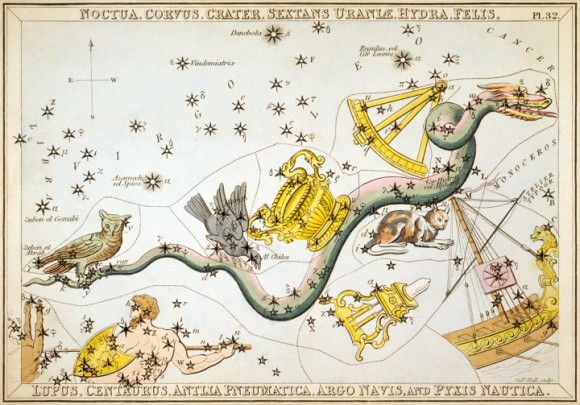
History of Observation:
The Crater constellation comes to us from Classical Antiquity and was recorded by Ptolemy in his 2nd-century CE tract the Almagest. However, it was also recognized by Chinese astronomers, where the stars associated with it were viewed as being part the Vermillion Bird of the South (Nan Fang Zhu Que). Along with the some of the stars from Hydra, they depict the Red Bird’s wings.
Notable Objects:
Crater has only a few bright stars associated with it and no Messier Objects. The brightest, Delta Crateris, is an orange giant located approximately 196 light yeas from Earth. The star is also known as Labrum (Latin for “the lip”), due to the fact that it was sometimes associated with the story of the Holy Grail.
Next is Alpha Crateris, an orange giant located approximately 174 light-years from Earth which is 80 times more luminous than our Sun. It is also known as Alkes, derived from the Arabic word alkas, which means “the cup”. Then there’s Beta Crateris, a white sub-giant that is located approximately 266 light years from Earth. This star is also known by the name Al Sharasif, which means “the ribs” in Arabic.
In terms of Deep Sky Objects, Crater has no associated Messier Objects, but a few galaxies can be found in its region of the night sky. These include the Crater 2 dwarf galaxy, a satellite galaxy of the Milky Way that is located approximately 380,000 light years from Earth. There’s also the spiral galaxy known as NGC 3511, which has a slight bar and is seen from Earth nearly edge-on.
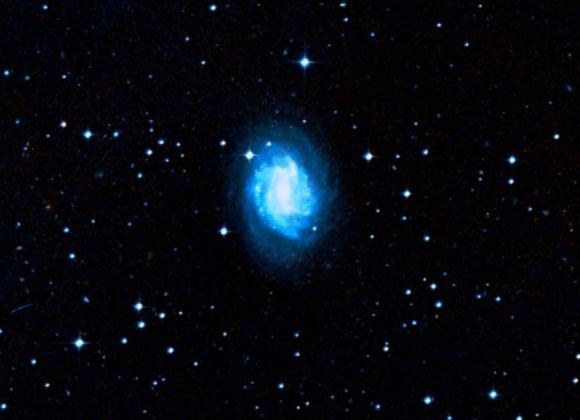
There’s also the NGC 3887 and NGC 2981 spiral galaxies, and the RX J1131 quasar, which is located 6 billion light years away from Earth. Interestingly, the black hole at the center of this quasar was the first to have its spin directly measured by astronomers.
Finding Crater:
Crater is visible at latitudes between +65° and -90° and is best seen at culmination during the month of April. It is comprised of only 4 main stars, and 12 stars with Bayer/Flamsteed designations. In order to spot these stars, observers should begin by looking for the Alpha star (the “a” shape on their star map) with binoculars.
Situated some 174 light-years from Earth, Alpha Crateris (the star’s official designation) is a spectral class K1 star – an orange giant that’s a little different from the rest. This is because Alkes is a “high velocity” star, which means it moves far faster than the stars around it. Another thing that sets it apart is its high metal content, which according to some researchers, it may have picked up when it came from the inner, metal-rich part of the Galaxy.
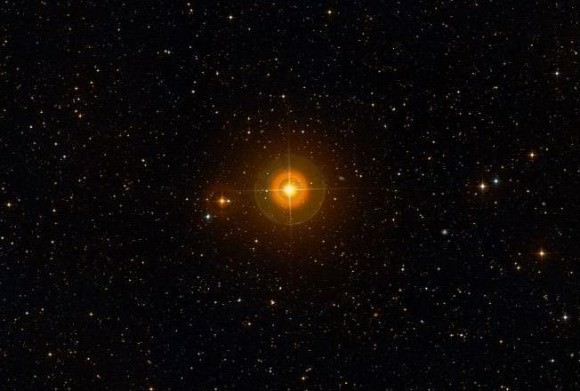
Next, observers should look to Beta Crateris (the “B” shape on the map) which also goes by the name of Al Sharasif. This star is not an ordinary one either. For starters, Al Sharasif is about 265 light-years from our solar system, and it’s a white sub-giant star. To boot, it also has a low mass, white dwarf companion – which is why astronomers classify it as a Sirius-like system.
Next up is Delta Crateris – the “8” symbol on the map – which is an orange giant, spectral class K0III star with an apparent magnitude of 3.56. In time, this star will become an even larger giant, eventually turning into a Mira-type variable star before ending its life as a white dwarf. Oddly enough, Labrum has a very low metal content compared to its Crater-neighbors, containing about 40% as much iron as our own Sun.
At this point, observers with telescopes and have a look at Gamma Crateris – the “Y” shape on the map. Gamma Crateris is a fixed binary white dwarf star with an easy separation of 5.2″. Gamma itself is 89 light-years for Earth, which is rather hard to believe when you try to seek out the 9.5 stellar magnitude companion that accompanies it.
Although this is a disparate double star, it is still quite fun and easy to spot with a small telescope. For a challenge, try Iota Crateris – a close binary star with an 11th magnitude companion that’s only separated by 1.4″. Psi Crateris is an even closer binary. Both stars are within a half magnitude of each other, but the separation is only 0.2″.
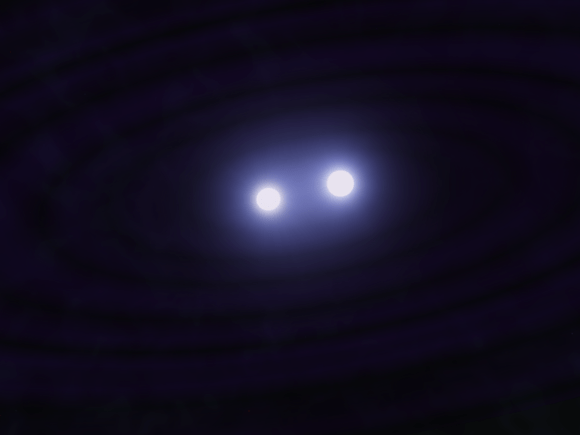
Next up is R Crateris, a variable star that can be observed with binoculars, and which is located at RA 10 56 Dec -17 47. You will notice it by its lovely red color and its nice change of magnitude, which goes from 8 to 9.5 in a period of about 160 days. And then there’s SZ Crateris, a magnitude 8.1 variable star. It is a nearby star system located about 44 light years from the Sun and is known as Gliese 425 – which in the past was known as Abt’s Star.
While there’s no brighter deep sky objects for binoculars or small telescopes, there are a couple of challenging galaxies in the Crater constellation that are well suited to a large aperture. Let’s start with the brightest – elliptical galaxy NGC 3962 – which is easy to spot (like all elliptical galaxies), though there’s not much detail to be seen. Even if it is not terribly exciting to behold, it is on the Herschel 400 observing list.
And then there’s NGC 3887 (11h47.1 -16 51), a nice spiral galaxy that’s only slightly fainter. It has two faint stars which accompany it and a stellar nucleus which occasionally makes an appearance and provides an opportunity for some very interesting viewing. Both of these galaxies are in the slightly fainter range, both being just under magnitude 11.
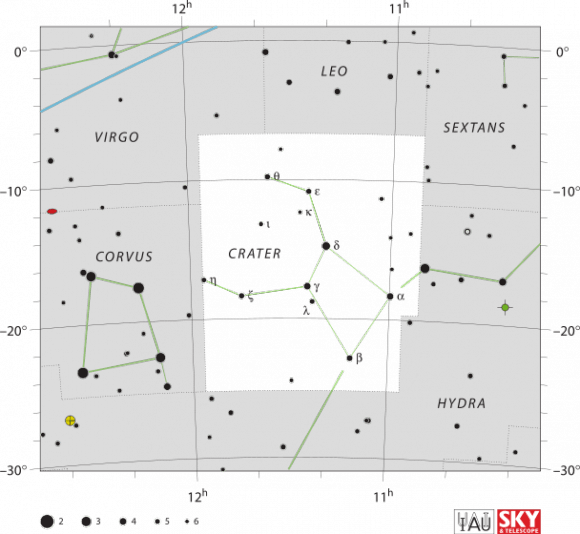
Observers who are skilled with telescopes should also keep and eye out for NGC 3511 (11h03.4 -23 05), a spiral galaxy of magnitude 11.5. It is joined in the same field of view by NGC 3513, a barred spiral galaxy that is a full magnitude dimmer. People with larger telescopes should also take a crack at spotting NGC 3672 (11h25.0 -09 48), a faint spiral galaxy that nevertheless has nice halo and a bright, apparent nucleus.
And last, but not least, there is NGC 3981 (11h56.1 -19 54), a beautifully inclined, magnitude 12 spiral galaxy that has a bright nucleus, and which sometimes shows some spiral galaxy structure when observing conditions are right.
Drink up… the “Cup” is waiting!
We have written many interesting articles about the constellation here at Universe Today. Here is What Are The Constellations?, What Is The Zodiac?, and Zodiac Signs And Their Dates.
Be sure to check out The Messier Catalog while you’re at it!
For more information, check out the IAUs list of Constellations, and the Students for the Exploration and Development of Space page on Canes Venatici and Constellation Families.
Sources:
Messier 51 – the Whirlpool Galaxy
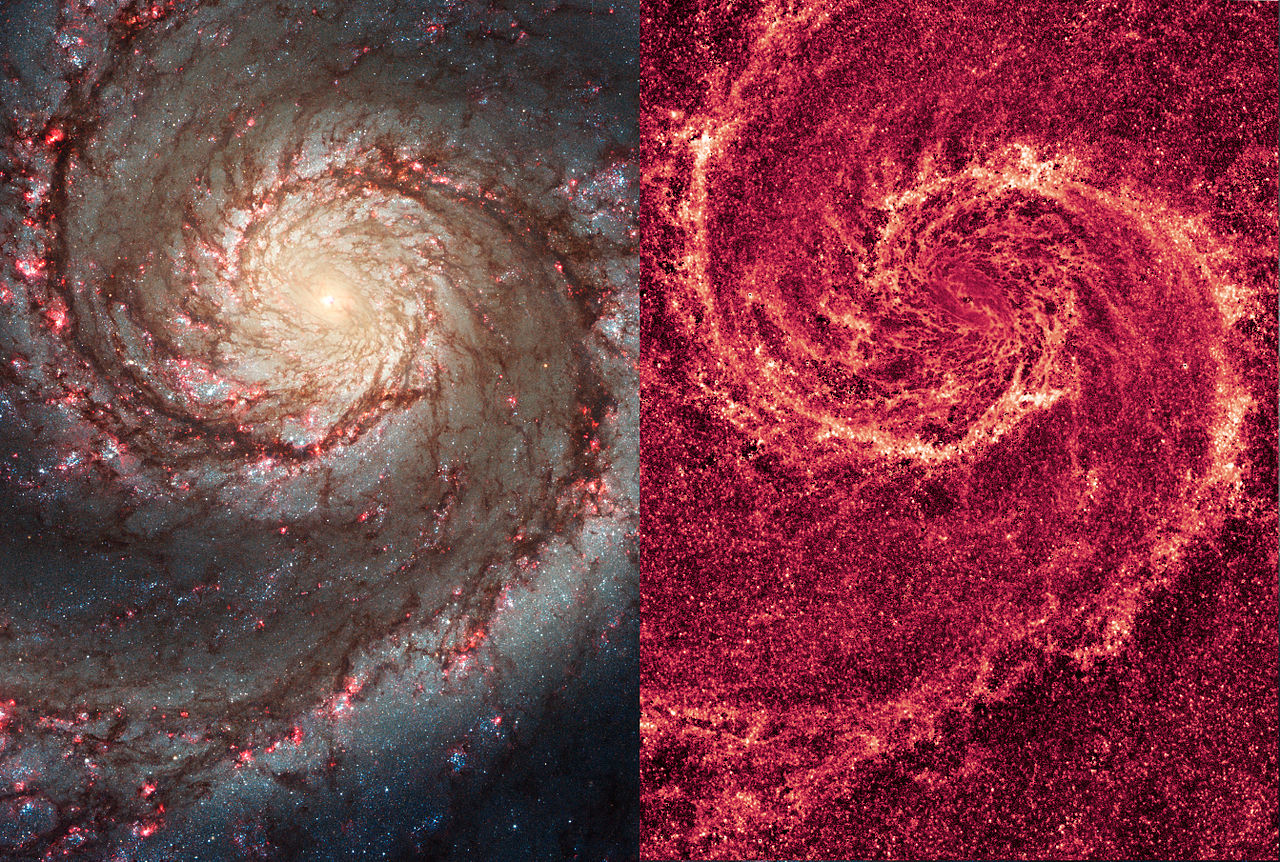
Welcome back to Messier Monday! In our ongoing tribute to the great Tammy Plotner, we take a look at that swirling, starry customer, the Whirlpool Galaxy!
During the 18th century, famed French astronomer Charles Messier noted the presence of several “nebulous objects” in the night sky. Having originally mistaken them for comets, he began compiling a list of them so that others would not make the same mistake he did. In time, this list (known as the Messier Catalog) would come to include 100 of the most fabulous objects in the night sky.
One of these is the spiral galaxy located in the constellation Canes Venatici known as the Whirlpool Galaxy (aka. Messier 51). Located between 19 and 27 million light-years from the Milky Way, this deep sky object was the very first to be classified as a spiral galaxy. It is also one of the best known galaxies among amateur astronomers, and is easily observable using binoculars and small telescopes.
Description:
Located some 37 million light years away, M51 is the largest member of a small group of galaxies, which also houses M63 and a number of fainter galaxies. To this time, the exact distance of this group isn’t properly known… Even when a 2005 supernova event should have helped astronomers to correctly calculate! As K. Takats stated in a study:
“The distance to the Whirlpool galaxy (M51, NGC 5194) is estimated using published photometry and spectroscopy of the Type II-P supernova SN 2005cs. Both the expanding photosphere method (EPM) and the standard candle method (SCM), suitable for SNe II-P, were applied. The average distance (7.1 +/- 1.2 Mpc) is in good agreement with earlier surface brightness fluctuation and planetary nebulae luminosity function based distances, but slightly longer than the distance obtained by Baron et al. for SN 1994I via the spectral fitting expanding atmosphere method. Since SN 2005cs exhibited low expansion velocity during the plateau phase, similarly to SN 1999br, the constants of SCM were recalibrated including the data of SN 2005cs as well. The new relation is better constrained in the low-velocity regime, that may result in better distance estimates for such SNe.”
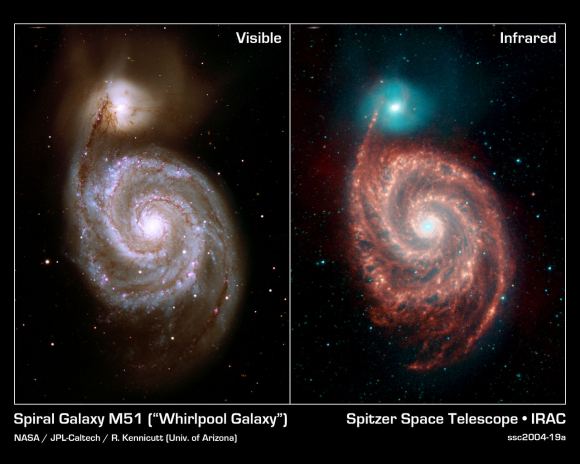
Of course, one of the most outstanding features of the Whirlpool Galaxy is its beautiful spiral structure – perhaps result of the close interaction between it and its companion galaxy NGC 5195? As S. Beckwith,
“This sharpest-ever image of the Whirlpool Galaxy, taken in January 2005 with the Advanced Camera for Surveys aboard NASA’s Hubble Space Telescope, illustrates a spiral galaxy’s grand design, from its curving spiral arms, where young stars reside, to its yellowish central core, a home of older stars. At first glance, the compact galaxy appears to be tugging on the arm. Hubble’s clear view, however, shows that NGC 5195 is passing behind the Whirlpool. The small galaxy has been gliding past the Whirlpool for hundreds of millions of years. As NGC 5195 drifts by, its gravitational muscle pumps up waves within the Whirlpool’s pancake-shaped disk. The waves are like ripples in a pond generated when a rock is thrown in the water. When the waves pass through orbiting gas clouds within the disk, they squeeze the gaseous material along each arm’s inner edge. The dark dusty material looks like gathering storm clouds. These dense clouds collapse, creating a wake of star birth, as seen in the bright pink star-forming regions. The largest stars eventually sweep away the dusty cocoons with a torrent of radiation, hurricane-like stellar winds, and shock waves from supernova blasts. Bright blue star clusters emerge from the mayhem, illuminating the Whirlpool’s arms like city streetlights.”
But there were more surprises just waiting to be found – like a black hole, surrounded by a ring of dust. What makes it even more odd is a secondary ring crosses the primary ring on a different axis, a phenomenon that is contrary to expectations and a pair of ionization cones extend from the axis of the main dust ring. As H. Ford,
“This image of the core of the nearby spiral galaxy M51, taken with the Wide Field Planetary camera (in PC mode) on NASA’s Hubble Space Telescope, shows a striking , dark “X” silhouetted across the galaxy’s nucleus. The “X” is due to absorption by dust and marks the exact position of a black hole which may have a mass equivalent to one-million stars like the sun. The darkest bar may be an edge-on dust ring which is 100 light-years in diameter. The edge-on torus not only hides the black hole and accretion disk from being viewed directly from earth, but also determines the axis of a jet of high-speed plasma and confines radiation from the accretion disk to a pair of oppositely directed cones of light, which ionize gas caught in their beam. The second bar of the “X” could be a second disk seen edge on, or possibly rotating gas and dust in MS1 intersecting with the jets and ionization cones.”
History of Observation:
The Whirlpool Galaxy was first discovered by Charles Messier on October 13th, 1773 and re-observed again for his records on January 11th, 1774. As he wrote of his discovery in his notes:
“Very faint nebula, without stars, near the eye of the Northern Greyhound [hunting dog], below the star Eta of 2nd magnitude of the tail of Ursa Major: M. Messier discovered this nebula on October 13, 1773, while he was watching the comet visible at that time. One cannot see this nebula without difficulties with an ordinary telescope of 3.5 foot: Near it is a star of 8th magnitude. M. Messier reported its position on the Chart of the Comet observed in 1773 & 1774. It is double, each has a bright center, which are separated 4’35”. The two “atmospheres” touch each other, the one is even fainter than the other.”
It would be his faithful friend and assistant, Pierre Mechain who would discover NGC 5195 on March 21st, 1781. Even though it would be many, many years before it was proven that galaxies were indeed independent systems, historic astronomers were much, much sharper than we gave them credit for. Sir William Herschel would observe M51 many times, but it would be his son John who would be the very first to comment on M51’s scheme:
“This very singular object is thus described by Messier: – “Nebuleuse sans etoiles.” “On ne peut la voir que difficilement avec une lunette ordinaire de 3 1/2 pieds.” “Elle est double, ayant chacune un centre brillant eloigne l’un de l’autre de 4′ 35″. Les deux atmospheres se touchent.” By this description it is evident that the peculiar phenomena of the nebulous ring which encircles the central nucleus had escaped his observation, as might have been expected from the inferior light of his telescopes. My Father describes it in his observations of Messier’s nebulae as a bright round nebula, surrounded by a halo or glory at a distance from it, and accompanied by a companion; but I do not find that the partial subdivision of the ring into two branches throughout its south following limb was noticed by him. This is, however, one of its most remarkable and interesting features. Supposing it to consist of stars, the appearance it would present to a spectator placed on a planet attendant on one of them eccentrically situated towards the north preceding quarter of the central mass, would be exactly similar to that of our Milky Way, traversing in a manner precisely analogous the firmament of large stars, into which the central cluster would be seen projected, and (owing to its distance) appearing, like it, to consist of stars much smaller than those in other parts of the heavens. Can it, then, be that we have here a brother-system bearing a real physical resemblance and strong analogy of structure to our own? Were it not for the subdivision of the ring, the most obvious analogy would be that of the system of Saturn, and the idea of Laplace respecting the formation of that system would be powerfully recalled by this object. But it is evident that all idea of symmetry caused by rotation on an axis must be relinquished, when we consider that the elliptic form of the inner subdivided portion indicates with extreme probability an elevation of that portion above the plane of the rest, so that the real form must be that of a ring split through half its circumference, and having the split portions set asunder at an angle of about 45 deg each to the plane of the other.”
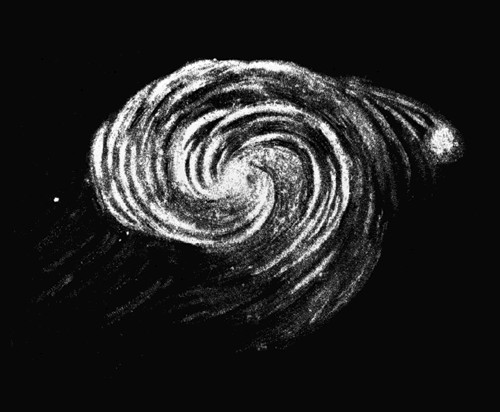
As with other Messier Objects, Admiral Smyth also had some insightful and poetic observations to add. As he wrote of this galaxy in September of 1836:
“We have then an object presenting an amazing display of the uncontrollable energies of the Omnipotence, the contemplation of which compels reason and admiration to yield to awe. On the outermost verge of telescopic reach we perceive a stellar universe similar to that to which we belong, whose vast amplitudes no doubt are peopled with countless numbers of percipient beings; for those beautiful orbs cannot be considered as mere masses of inert matter.
And it is interesting to know that, if there be intelligent existence, an astronomer gazing at our distant universe, will see it, with a good telescope, precisely under the lateral aspect which theirs presents to us. But after all what do we see? Both that wonderful universe, our own, and all which optical assistance has revealed to us, may be only the outliers of a cluster immensely more numerous.
The millions of suns we perceive cannot comprise the Creator’s Universe. There are no bounds to infinitude; and the boldest views of the elder Herschel only placed us as commanding a ken whose radius is some 35,000 times longer than the distance of Sirius from us. Well might the dying Laplace explain: “That which we know is little; that which we know not is immense.”
Lord Rosse would continue on in 1844 with his 6-feet (72-inch) aperture, 53-ft FL “Leviathan” telescope, but he was a man of fewer words.
“The greater part of the observations were made when the eye was affected by lamp-light, which made it difficult to estimate correctly the centre of the nucleus; it was of importance that no time should be unnecessarily spent, and after the lamp had been used a new measure was taken, as it was judged that the object was sufficiently seen. With the brighter stars this would frequently happen before the nucleus was well defined, as all impediments to vision seem to affect nebulae much more than stars the light of which would be estimated as of the same intensity. In the foregoing list the greatest discrepancies are in the measures of bright objects, and this is probably the proper account of it. No stars have been inserted in the sketch which are not in the table of the measurements. The general appearance of the object would have been better given if the minute stars had been put in from the eye-sketch, but it would have created confusion.”
May the stars from this distant island universe fill your eyes!
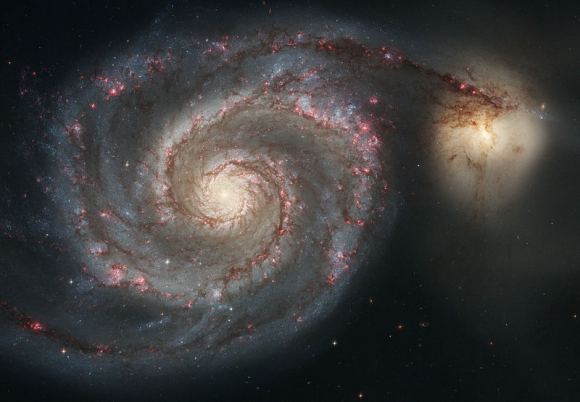
Locating Messier 51:
Locating M51 isn’t too hard if you have dark skies, but this particular galaxy is very difficult where light pollution of moonlight is present. To find it, start with Eta UM, the star at the handle of the Big Dipper. In the finderscope or binoculars, you’ll clearly see 24 UM to the southwest. Now, center your optics there and move slowly southwest towards Cor Caroli (Alpha CVn) and you’ll find it!
In locations where skies are clear and dark, it is easy to see spiral structure in even small telescopes, or to make out the galaxy in binoculars – but even a change in sky conditions can hide it from a good location. Rich field telescopes with fast focal lengths to an outstanding job on this galaxy and companion and you may be able to make out the nucleus of both galaxies on a good night from even a bad location.
Object Name: Messier 51
Alternative Designations: M51, NGC 5194, The Whirlpool Galaxy
Object Type: Type Sc Galaxy
Constellation: Canes Venatici
Right Ascension: 13 : 29.9 (h:m)
Declination: +47 : 12 (deg:m)
Distance: 37000 (kly)
Visual Brightness: 8.4 (mag)
Apparent Dimension: 11×7 (arc min)
We have written many interesting articles about Messier Objects here at Universe Today. Here’s Tammy Plotner’s Introduction to the Messier Objects, , M1 – The Crab Nebula, M8 – The Lagoon Nebula, and David Dickison’s articles on the 2013 and 2014 Messier Marathons.
Be to sure to check out our complete Messier Catalog. And for more information, check out the SEDS Messier Database.
Sources:
Messier 33 – The Triangulum Galaxy
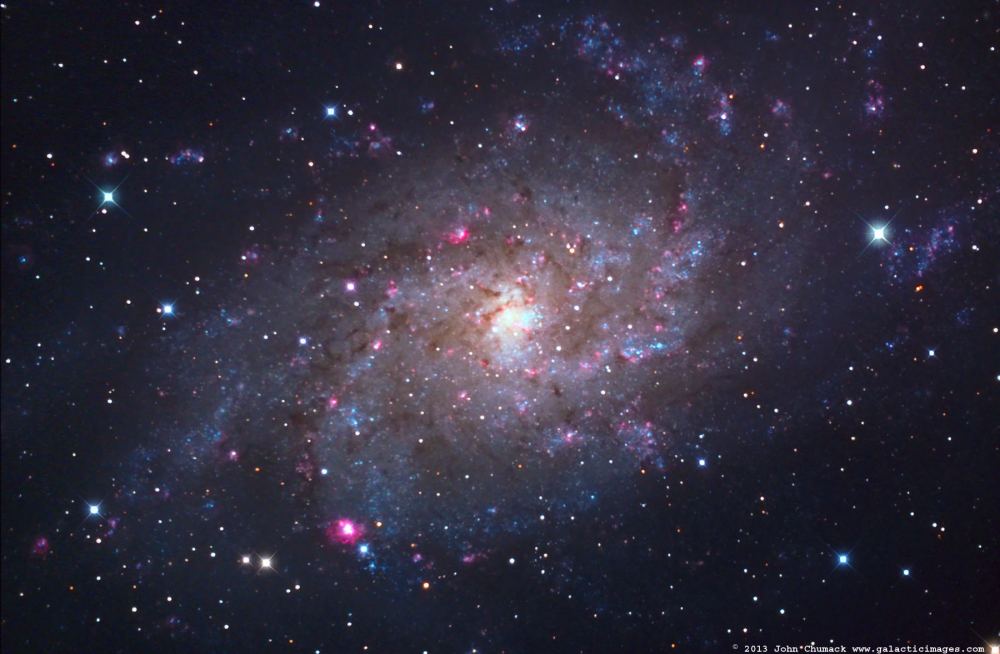
Welcome back to Messier Monday! In our ongoing tribute to the great Tammy Plotner, we take a look at the Triangulum Galaxy, also known as Messier 33. Enjoy!
During the 18th century, famed French astronomer Charles Messier noted the presence of several “nebulous objects” in the night sky. Having originally mistaken them for comets, he began compiling a list of them so that others would not make the same mistake he did. In time, this list (known as the Messier Catalog) would come to include 100 of the most fabulous objects in the night sky.
One of these is the Triangulum Galaxy, a spiral galaxy located approximately 3 million light-years from Earth in the direction of the Triangulum constellation. As the third-largest member of the Local Group of galaxies (behind the Andromeda Galaxy and the Milky Way), it is the one of the most distant objects that can be seen with the naked eye. Much like M32, M33 is very close to Andromeda, and is believed to be a satellite of this major galaxy.
Description:
At some 3 million light years away from Earth, the Triangulum Galaxy is the third largest galaxy in our Local Group and it may be a gravitationally bound companion of the Andromeda Galaxy. Its beautiful spiral arms show multitudes of red HII regions and blue clouds of young stars. The largest of these HII regions (NGC 604) spans nearly 1500 across and is the largest so far known.

It has a spectrum similar to the Orion Nebula – our own Milky Way’s most celebrated starbirth region. “M33 is a gigantic laboratory where you can watch dust being created in novae and supernovae, being distributed in the winds of giant stars, and being reborn in new stars,” said University of Minnesota researcher and lead author Elisha Polomski. By studying M33, “you can see the Universe in a nutshell.”
Of course, our curiousity about our neighboring galaxy has driven us to try to understand more over the years. Once Edwin Hubble set the standard with Cepheid variables, we began measuring distance by discovering about 25 of them in M33. By 2004 we were studying the red giant star branch to peer even further. As A.W. McConnachie said in a 2004 study of the galaxy:
“The absolute bolometric luminosity of the point of core helium ignition in old, metal-poor, red giant stars is of roughly constant magnitude, varying only very slightly with mass or metallicity. It can thus be used as a standard candle. This technique then allows for the determination of realistic uncertainties which reflect the quality of the luminosity function used. Finally, we apply our technique to the Local Group spiral galaxy M33 and the dwarf galaxies Andromeda I and II, and derive distance. The result for M33 is in excellent agreement with the Cepheid distances to this galaxy, and makes the possibility of a significant amount of reddening in this object unlikely.”
By 2005, astronomers had detected two water masers on either side of M33 and for the first time ever – revealed what direction it as going in. According to Andreas Brunthaler (et al), who published a study about the distance and proper motion of the galaxy in 2005:
“We measured the angular rotation and proper motion of the Triangulum Galaxy (M33) with the Very Long Baseline Array by observing two H2O masers on opposite sides of the galaxy. By comparing the angular rotation rate with the inclination and rotation speed, we obtained a distance of 730 +/- 168 kiloparsecs. This distance is consistent with the most recent Cepheid distance measurement. This distance is consistent with the most recent Cepheid distance measurement. M33 is moving with a velocity of 190 +/- 59 kilometers per second relative to the Milky Way. These measurements promise a method to determine dynamical models for the Local Group and the mass and dark-matter halos of M31, M33, and the Milky Way.”
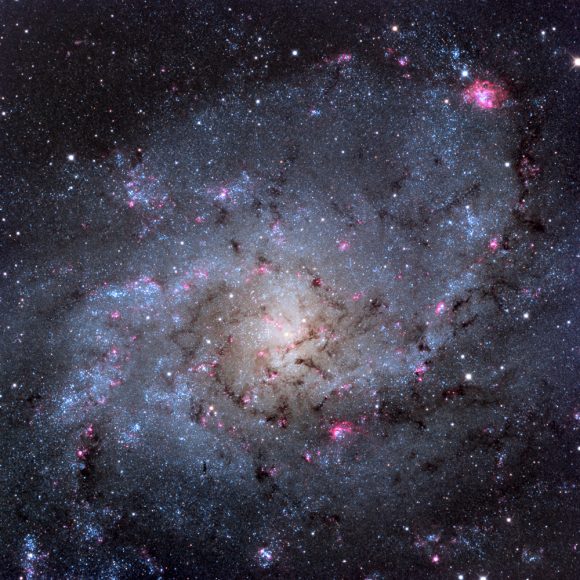
Yes, it’s moving toward the Andromeda Galaxy, much like how Andromeda is moving towards us! In 2006, a group of astronomers announced the discovery of an eclipsing binary star in M33. As A.Z. Bonanos, the lead author of the study that detailed the discovery, said:
“We present the first direct distance determination to a detached eclipsing binary in M33, which was found by the DIRECT Project. Located in the OB 66 association, it was one of the most suitable detached eclipsing binaries found by DIRECT for distance determination, given its 4.8938 day period.”
By studying the eclipsing binary, astronomers soon knew their size, distance, temperature and absolute magnitude. But more was yet to come! In 2007, the Chandra X-ray Observatory revealed even more when a black hole nearly 16 times the mass of the Sun was revealed. The black hole, named M33 X-7, orbits a companion star which it eclipses every 3.5 days. This means the companion star must also have an incredibly large mass as well….
Yet how huge must the parent star have been to have formed a black hole in advance of its companion? As Jerome Orosz, of San Diego State University, was quoted as saying in a 2007 Chandra press release:
“This discovery raises all sorts of questions about how such a big black hole could have been formed. Massive stars can be much less extravagant than people think by hanging onto a lot more of their mass toward the end of their lives. This can have a big effect on the black holes that these stellar time-bombs make.”
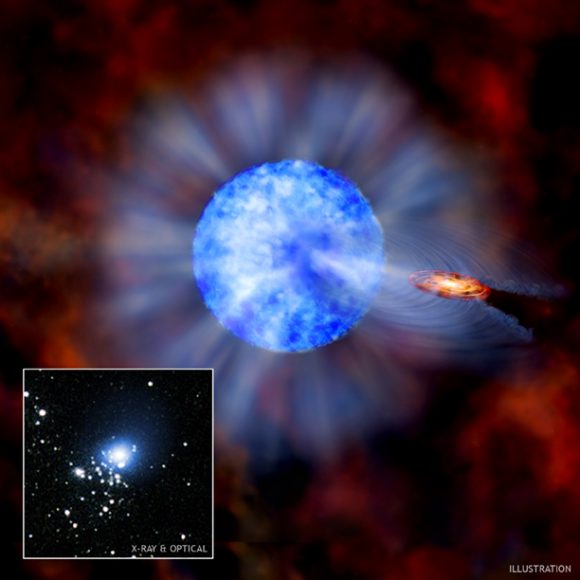
Stellar bombs? You bet. Gigantic stellar explosions even. Although no supernovae events have been detected in the Triangulum galaxy, it certainly doesn’t lack for evidence of supernova remnants. According to a 2004 study by F. Haberl and W. Pietsch of the Max-Planck-Institute:
“We present a catalogue of 184 X-ray sources within 50′ of the nucleus of the local group spiral galaxy M 33. The catalogue is derived from an analysis of the complete set of ROSAT archival data pointed in the direction of M 33 and contains X-ray position, existence likelihood, count rates and PSPC spectral hardness ratios. To identify the sources the catalog was correlated with previous X-ray catalogues, optical and radio catalogues. In addition sources were classified according to their X-ray properties. We find seven candidates for supersoft X-ray sources, of which two may be associated with known planetary nebulae in M 33. The majority of X-ray detected supernova remnants is also detected at radio frequencies and seen in optical lines. The low overall X-ray detection rate of optically selected SNRs can probably be attributed to their expansion into interstellar matter of low density.”
Or the creation of black holes…
History of Observation:
While the Triangulum Galaxy was probably first observed by Hodierna before 1654 (back when skies were dark), it was independently rediscovered by Charles Messier, and cataloged by him on August 25, 1764. As he recorded in his notes on the occasion:
“I have discovered a nebula between the head of the northern Fish and the large Triangle, a bit distant from a star which had not been known, of sixth magnitude, of which I have determined the position; the right ascension of that star was 22d 7′ 13″, and its declination 29d 54′ 10″ north: near that star, there is another one which is the first of Triangulum, described by the letter b. Flamsteed described it in his catalog, of sixth magnitude; it is less beautiful than that of which I have given the position, and one should set it to the rank of the stars of the eighth class. The nebula is a whitish light of 15 minutes in diameter, of an almost even density, despite a bit more luminous at two third of its diameter; it doesn’t contain any star: one sees it with difficulty with an ordinary refractor of one foot.”
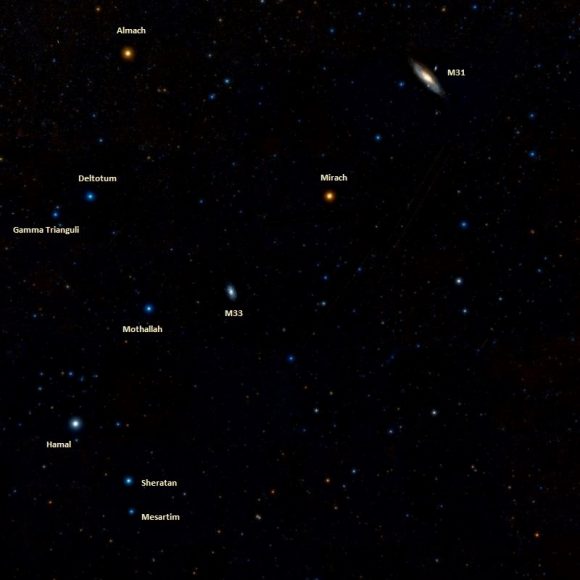
While Sir William Herschel wouldn’t publish papers on Messier’s findings, he was an astronomically curious soul and couldn’t help but study M33 intently on his own, writing:
“There is a suspicion that the nebula consists of exceedingly small stars. With this low power it has a nebulous appearance; and it vanishes when I put on the higher magnifying powers of 278 and 460.” He would continue to observe this grand galaxy again and again over the years, cataloging its various regions with their own separate numbers and keeping track of his findings: “The stars of the cluster are the smallest points imaginable. The diameter is nearly 18 minutes.”
Yet it would take a very special observer, one named Bill Parsons – the third Earl of Rosse – to become the very first to describe it as spiral. As he wrote of it:
“September 16, 1849. – New spiral: Alpha the brighter branch; Gamma faint; Delta short but pretty bright; Beta pretty distinct; Epsilon but suspected; the whole involved in a faint nebula, which probably extends past several knots which lie about it in different directions. Faint nebula seems to extend very far following: drawing taken.”
Quite the description indeed, since it would eventually lead to Rosse’s description of M33 being “…full of knots. Spiral arrangement. Two similar curves like an “S” cross in the center”, and to other astronomers discovering that these “spiral nebulae” were extra-galactic!
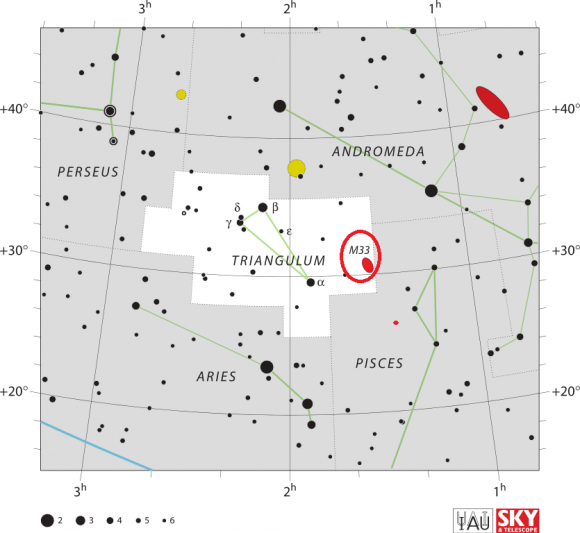
Locating Messier 33:
While actually locating Messier 33 isn’t so difficult, seeing Messier 33 can be. Even though it is billed at nearly unaided eye magnitude, this huge, low surface brightness galaxy requires some experience with equipment and observing conditions or you may hunt forever in the right place and never find it. Let’s begin first by getting you in the proper area! First locate the Great Square of Pegasus – and its easternmost bright star, Alpha. About a hand span further east you will see the brightest star in Triangulum – Alpha.
M33 is just a couple of degrees (about 2 finger widths) west. Now, the most important part to understand is that you must use the lowest magnification possible, or you won’t be able to see the proverbial forest because of the trees. The image you see here at the top of the page is around a full degree of sky – about 1/3 the field of view of average binoculars and far larger than your average telescope eyepiece.
However, by using the least amount of magnification with a telescope you are causing M33 to appear much smaller – allowing it to fit within eyepiece field of view range. The larger the aperture, the more light it gathers and the brighter the image will be. The next thing to understand is M33 really is low surface brightness… Light pollution, a fine haze in the sky, moonlight… All of these things will make it difficult to find. Yet, there are places left here on Earth where the Triangulum Galaxy can be seen with no optical aid at all!
Enjoy your quest for M33. You may find it your first time out and it may be years before you see it in all its glory. But when you do, we guarantee you’ll never forget! Be sure to enjoy this video of the Triangulum galaxy too, courtesy of the European Southern Observatory:
Enjoy your quest for M33. You may find it your first time out and it may be years before you see it in all its glory. But when you do, we guarantee you’ll never forget!
And here are the quick facts on M33 to help you get started:
Object Name: Messier 33
Alternative Designations: M33, NGC 598, Triangulum Galaxy, Pinwheel Galaxy
Object Type: Type Sc, Spiral Galaxy
Constellation: Triangulum
Right Ascension: 01 : 33.9 (h:m)
Declination: +30 : 39 (deg:m)
Distance: 3000 (kly)
Visual Brightness: 5.7 (mag)
Apparent Dimension: 73×45 (arc min)
We have written many interesting articles about Messier Objects here at Universe Today. Here’s Tammy Plotner’s Introduction to the Messier Objects, , M1 – The Crab Nebula, M8 – The Lagoon Nebula, and David Dickison’s articles on the 2013 and 2014 Messier Marathons.
Be to sure to check out our complete Messier Catalog. And for more information, check out the SEDS Messier Database.
Sources:

